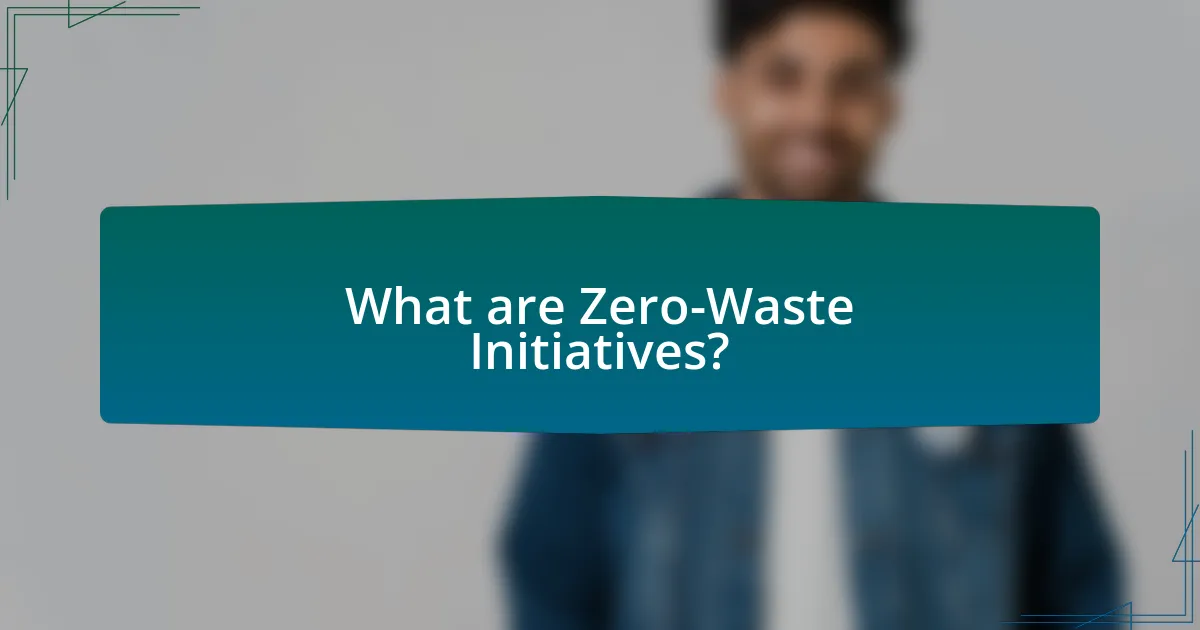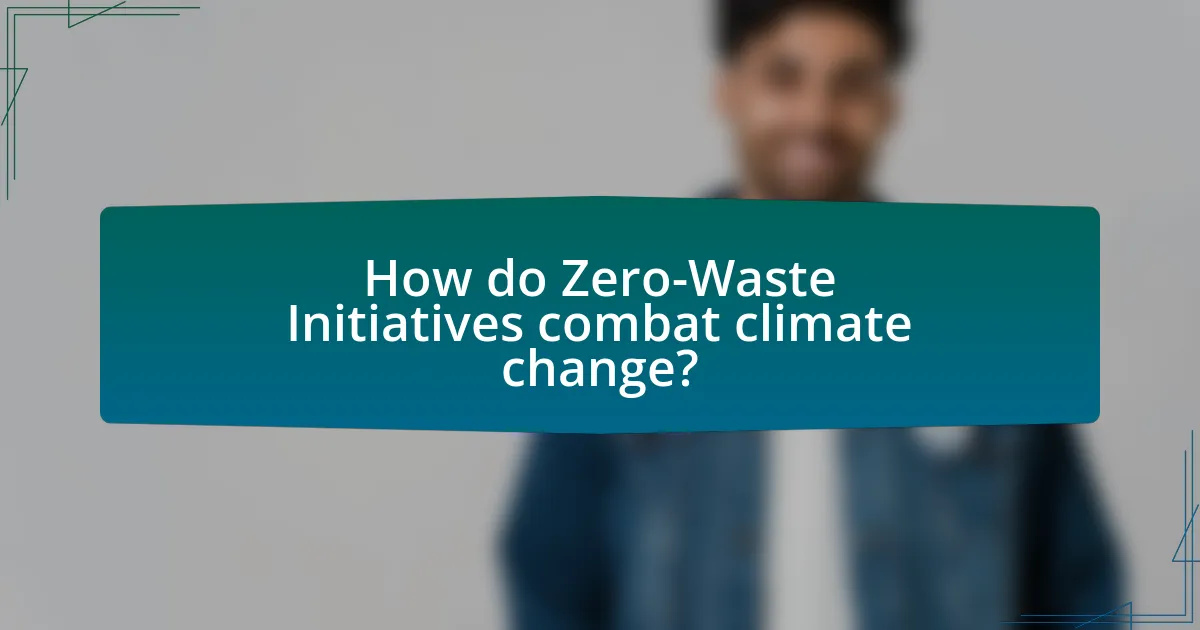Zero-Waste Initiatives are strategies designed to minimize waste generation through the principles of reduction, reuse, and recycling, ultimately aiming to conserve resources and mitigate environmental impact. These initiatives play a crucial role in combating climate change by significantly reducing greenhouse gas emissions associated with waste disposal and resource extraction. The article outlines how Zero-Waste practices function in society, their key principles, and their importance for environmental sustainability. It also discusses the challenges faced in implementing these initiatives, the role of education and collaboration among stakeholders, and practical steps individuals can take to support Zero-Waste efforts.

What are Zero-Waste Initiatives?
Zero-Waste Initiatives are strategies aimed at reducing waste generation to the maximum extent possible, promoting the reuse and recycling of materials. These initiatives focus on designing products and systems that minimize waste, thereby conserving resources and reducing environmental impact. For instance, the Zero Waste International Alliance defines zero waste as a goal that encourages the redesign of resource life cycles so that all products are reused. This approach not only helps in reducing landfill waste but also contributes to mitigating climate change by lowering greenhouse gas emissions associated with waste disposal and resource extraction.
How do Zero-Waste Initiatives function in society?
Zero-Waste Initiatives function in society by promoting the reduction, reuse, and recycling of materials to minimize waste and environmental impact. These initiatives encourage individuals, businesses, and communities to adopt sustainable practices that divert waste from landfills, thereby reducing greenhouse gas emissions associated with waste decomposition. For instance, cities implementing zero-waste policies often achieve significant reductions in waste generation; San Francisco, for example, has diverted over 80% of its waste from landfills since adopting its zero-waste goal in 2002. This demonstrates the effectiveness of such initiatives in fostering a circular economy, where resources are kept in use for as long as possible, ultimately contributing to climate change mitigation.
What are the key principles of Zero-Waste Initiatives?
The key principles of Zero-Waste Initiatives include waste prevention, resource recovery, and sustainable consumption. Waste prevention focuses on reducing the amount of waste generated at the source, emphasizing the importance of designing products and processes that minimize waste. Resource recovery involves recycling and composting materials to keep them in use and out of landfills, thereby conserving natural resources. Sustainable consumption encourages individuals and businesses to make informed choices that prioritize environmentally friendly products and practices. These principles collectively aim to create a circular economy, where materials are reused and repurposed, significantly reducing environmental impact and contributing to climate change mitigation.
How do these principles contribute to waste reduction?
Zero-waste principles contribute to waste reduction by promoting practices that minimize resource consumption and maximize recycling and reuse. These principles encourage individuals and organizations to rethink their consumption habits, leading to less waste generation. For instance, the implementation of the “reduce, reuse, recycle” hierarchy effectively decreases landfill contributions by prioritizing waste prevention and resource efficiency. According to a study by the Ellen MacArthur Foundation, adopting circular economy principles can lead to a 70% reduction in waste generation in certain sectors, demonstrating the significant impact of these principles on waste reduction.
Why are Zero-Waste Initiatives important for the environment?
Zero-Waste Initiatives are important for the environment because they significantly reduce waste generation and promote sustainable resource use. By aiming to eliminate waste at the source, these initiatives help decrease landfill overflow, which is responsible for methane emissions—a potent greenhouse gas that contributes to climate change. According to the Environmental Protection Agency, landfills are the third-largest source of methane emissions in the United States. Furthermore, Zero-Waste practices encourage recycling and composting, which can conserve natural resources and reduce the energy consumption associated with producing new materials. For instance, recycling aluminum saves 95% of the energy required to create new aluminum from raw materials. Thus, Zero-Waste Initiatives play a crucial role in mitigating environmental degradation and combating climate change.
What impact do they have on landfill waste?
Zero-waste initiatives significantly reduce landfill waste by promoting recycling, composting, and waste reduction practices. These initiatives aim to divert materials from landfills, thereby decreasing the volume of waste that ends up in these sites. For instance, according to the Environmental Protection Agency, recycling and composting prevented the release of approximately 186 million metric tons of carbon dioxide equivalent into the air in 2018, demonstrating the positive environmental impact of reducing landfill waste. By implementing zero-waste strategies, communities can effectively minimize their landfill contributions and promote sustainable waste management practices.
How do they influence resource conservation?
Zero-waste initiatives influence resource conservation by promoting the reduction, reuse, and recycling of materials, thereby minimizing waste generation. These initiatives encourage individuals and businesses to adopt sustainable practices, such as using reusable products and composting organic waste, which directly decreases the demand for new resources. For example, a study by the Ellen MacArthur Foundation found that transitioning to a circular economy, which is a key principle of zero-waste initiatives, could reduce global greenhouse gas emissions by 39% by 2030, highlighting the significant impact of resource conservation on climate change mitigation.

How do Zero-Waste Initiatives combat climate change?
Zero-Waste Initiatives combat climate change by significantly reducing waste generation and promoting resource efficiency. These initiatives encourage practices such as recycling, composting, and reusing materials, which lower greenhouse gas emissions associated with waste disposal and production. For instance, the Environmental Protection Agency (EPA) reports that recycling and composting prevented the release of approximately 186 million metric tons of carbon dioxide equivalent into the air in 2013 alone. By minimizing landfill use and fostering a circular economy, Zero-Waste Initiatives contribute to a decrease in the carbon footprint, thereby mitigating climate change impacts.
What role do they play in reducing greenhouse gas emissions?
Zero-waste initiatives play a crucial role in reducing greenhouse gas emissions by minimizing waste generation and promoting recycling and composting. These initiatives divert organic and recyclable materials from landfills, where they would otherwise decompose and release methane, a potent greenhouse gas. For instance, the Environmental Protection Agency (EPA) estimates that composting and recycling prevented the release of approximately 186 million metric tons of carbon dioxide equivalent into the atmosphere in 2018 alone. By fostering a circular economy, zero-waste initiatives not only reduce emissions but also encourage sustainable consumption patterns, further mitigating climate change impacts.
How does waste management affect carbon footprints?
Waste management significantly affects carbon footprints by reducing greenhouse gas emissions associated with waste decomposition and incineration. Effective waste management practices, such as recycling and composting, minimize the amount of waste sent to landfills, where organic materials produce methane, a potent greenhouse gas. For instance, the U.S. Environmental Protection Agency reports that landfills are the third-largest source of methane emissions in the country. By diverting waste from landfills through recycling and composting, communities can lower their overall carbon emissions, contributing to climate change mitigation efforts.
What are the long-term benefits of reducing waste on climate change?
Reducing waste has significant long-term benefits for climate change by decreasing greenhouse gas emissions and conserving natural resources. When waste is minimized, less material ends up in landfills, which are major sources of methane, a potent greenhouse gas. For instance, the Environmental Protection Agency (EPA) reports that landfills account for approximately 14% of U.S. methane emissions. Additionally, reducing waste leads to lower energy consumption in manufacturing processes, as less raw material extraction and processing is required. According to a study by the World Resources Institute, improving waste management practices can reduce global greenhouse gas emissions by up to 70% by 2050. Therefore, effective waste reduction strategies contribute to a more sustainable environment and help mitigate the impacts of climate change.
How can communities implement Zero-Waste Initiatives effectively?
Communities can implement Zero-Waste Initiatives effectively by establishing comprehensive waste management programs that prioritize reduction, reuse, and recycling. These programs should include educational campaigns to raise awareness about waste reduction practices, such as composting and responsible consumption. For instance, cities like San Francisco have achieved a diversion rate of over 80% through mandatory recycling and composting laws, demonstrating that structured policies can significantly reduce landfill waste. Additionally, engaging local businesses in sustainability practices and providing incentives for waste reduction can further enhance community participation and success in Zero-Waste efforts.
What strategies can local governments adopt?
Local governments can adopt strategies such as implementing comprehensive recycling programs, promoting composting initiatives, and establishing waste reduction policies. These strategies facilitate the transition to a zero-waste framework, which is essential for mitigating climate change impacts. For instance, cities like San Francisco have achieved a diversion rate of over 80% through mandatory recycling and composting laws, demonstrating the effectiveness of such policies in reducing landfill waste and greenhouse gas emissions.
How can individuals contribute to Zero-Waste efforts?
Individuals can contribute to Zero-Waste efforts by adopting practices that minimize waste generation and promote recycling and composting. For instance, individuals can reduce single-use plastics by using reusable bags, bottles, and containers, which significantly decreases plastic waste; studies show that plastic pollution can harm marine life and ecosystems. Additionally, individuals can practice mindful consumption by purchasing products with minimal packaging and supporting local businesses that prioritize sustainability. Composting organic waste can divert approximately 30% of household waste from landfills, reducing methane emissions, a potent greenhouse gas. By participating in community clean-up events and advocating for policies that support Zero-Waste initiatives, individuals can further amplify their impact on reducing waste and combating climate change.

What challenges do Zero-Waste Initiatives face?
Zero-Waste Initiatives face significant challenges, including public awareness, infrastructure limitations, and economic viability. Public awareness is crucial, as many individuals lack understanding of the zero-waste philosophy, which hinders participation. Infrastructure limitations arise from inadequate recycling and composting facilities, making it difficult to process materials effectively. Economic viability is also a concern, as initial costs for implementing zero-waste systems can be high, deterring businesses and municipalities from adopting these practices. According to a study by the Ellen MacArthur Foundation, transitioning to a circular economy, which includes zero-waste principles, could generate $4.5 trillion in economic benefits, highlighting the potential for long-term gains despite initial challenges.
What are the common barriers to implementing Zero-Waste practices?
Common barriers to implementing Zero-Waste practices include lack of awareness, insufficient infrastructure, and resistance to change. Lack of awareness among consumers and businesses leads to minimal engagement with Zero-Waste initiatives, as many do not understand the benefits or methods of reducing waste. Insufficient infrastructure, such as inadequate recycling facilities and composting programs, hampers effective waste management and limits the ability to divert materials from landfills. Resistance to change is often rooted in established habits and the perceived inconvenience of adopting new practices, making it difficult for individuals and organizations to transition to a Zero-Waste lifestyle. These barriers collectively hinder the widespread adoption of Zero-Waste practices, which are essential for combating climate change.
How does public perception affect Zero-Waste initiatives?
Public perception significantly influences Zero-Waste initiatives by shaping community engagement and support for sustainable practices. When the public views Zero-Waste initiatives positively, it leads to increased participation, funding, and policy support, which are crucial for the success of these programs. For instance, a survey conducted by the Ellen MacArthur Foundation found that 79% of consumers are willing to change their shopping habits to reduce plastic waste, indicating that favorable public perception can drive behavioral change. Conversely, negative perceptions, such as viewing Zero-Waste as inconvenient or elitist, can hinder participation and limit the effectiveness of these initiatives. Therefore, public perception acts as a critical determinant in the implementation and success of Zero-Waste strategies aimed at combating climate change.
What economic factors hinder the adoption of these initiatives?
High initial costs hinder the adoption of zero-waste initiatives. Many businesses face significant upfront investments in infrastructure, technology, and training required to implement these initiatives effectively. For instance, a study by the Ellen MacArthur Foundation highlights that transitioning to a circular economy, which includes zero-waste practices, can require substantial financial resources that small and medium enterprises may not readily have. Additionally, the lack of immediate financial incentives or return on investment can deter companies from pursuing these initiatives, as they often prioritize short-term profits over long-term sustainability goals.
How can these challenges be overcome?
Zero-waste initiatives can overcome challenges by implementing comprehensive education and community engagement programs. These programs raise awareness about waste reduction and encourage participation in sustainable practices, leading to increased community support and involvement. For instance, cities that have adopted zero-waste policies, such as San Francisco, have reported diversion rates exceeding 80% through effective public education and outreach efforts. Additionally, establishing partnerships with local businesses and organizations can facilitate resource sharing and innovation in waste management solutions, further enhancing the effectiveness of zero-waste initiatives.
What role does education play in promoting Zero-Waste practices?
Education plays a crucial role in promoting Zero-Waste practices by equipping individuals with the knowledge and skills necessary to reduce waste effectively. Through educational programs, people learn about the environmental impacts of waste, the principles of waste reduction, and practical strategies for implementing Zero-Waste practices in their daily lives. For instance, studies have shown that communities with strong educational initiatives around waste management experience a significant decrease in landfill contributions, highlighting the effectiveness of informed citizenry in achieving sustainability goals.
How can collaboration between stakeholders enhance Zero-Waste efforts?
Collaboration between stakeholders enhances Zero-Waste efforts by pooling resources, knowledge, and influence to create comprehensive waste reduction strategies. When businesses, governments, and communities work together, they can implement more effective recycling programs, share best practices, and develop innovative solutions tailored to local needs. For instance, a study by the Ellen MacArthur Foundation highlights that collaborative initiatives can lead to a 70% reduction in waste generation when stakeholders align their goals and share responsibilities. This collective approach not only maximizes impact but also fosters a culture of sustainability, encouraging broader participation and commitment to Zero-Waste principles.
What practical steps can individuals take to support Zero-Waste Initiatives?
Individuals can support Zero-Waste Initiatives by adopting practices that minimize waste generation. One practical step is to reduce single-use plastics by using reusable bags, bottles, and containers, which can significantly decrease plastic waste; for instance, a study by the Ellen MacArthur Foundation found that reducing plastic use could cut marine pollution by 50% by 2030. Another effective action is to compost organic waste, which diverts food scraps from landfills and reduces methane emissions; the U.S. Environmental Protection Agency states that composting can reduce landfill waste by up to 30%. Additionally, individuals can participate in local clean-up events and advocate for policies that promote recycling and waste reduction, thereby fostering community engagement and awareness. By implementing these steps, individuals contribute to a collective effort that aligns with Zero-Waste principles and combats climate change.
How can one start a Zero-Waste lifestyle at home?
To start a Zero-Waste lifestyle at home, one should begin by conducting a waste audit to identify the types and amounts of waste generated. This assessment allows individuals to target specific areas for reduction, such as food waste, packaging, and single-use items. Implementing strategies like using reusable bags, containers, and utensils can significantly decrease waste output. According to the Environmental Protection Agency, reducing waste not only conserves resources but also lowers greenhouse gas emissions, contributing to climate change mitigation. By adopting these practices, individuals can effectively initiate a Zero-Waste lifestyle that aligns with broader environmental goals.
What resources are available for learning about Zero-Waste practices?
Books, online courses, and community workshops are key resources for learning about Zero-Waste practices. Notable books include “Zero Waste Home” by Bea Johnson, which provides practical tips for reducing waste, and “The Zero Waste Lifestyle” by Amy Korst, which offers a comprehensive guide to living sustainably. Online platforms like Coursera and Udemy feature courses on sustainable living and waste reduction strategies. Additionally, local community centers often host workshops that teach Zero-Waste techniques, fostering hands-on learning and community engagement. These resources collectively equip individuals with the knowledge and skills necessary to adopt Zero-Waste practices effectively.


